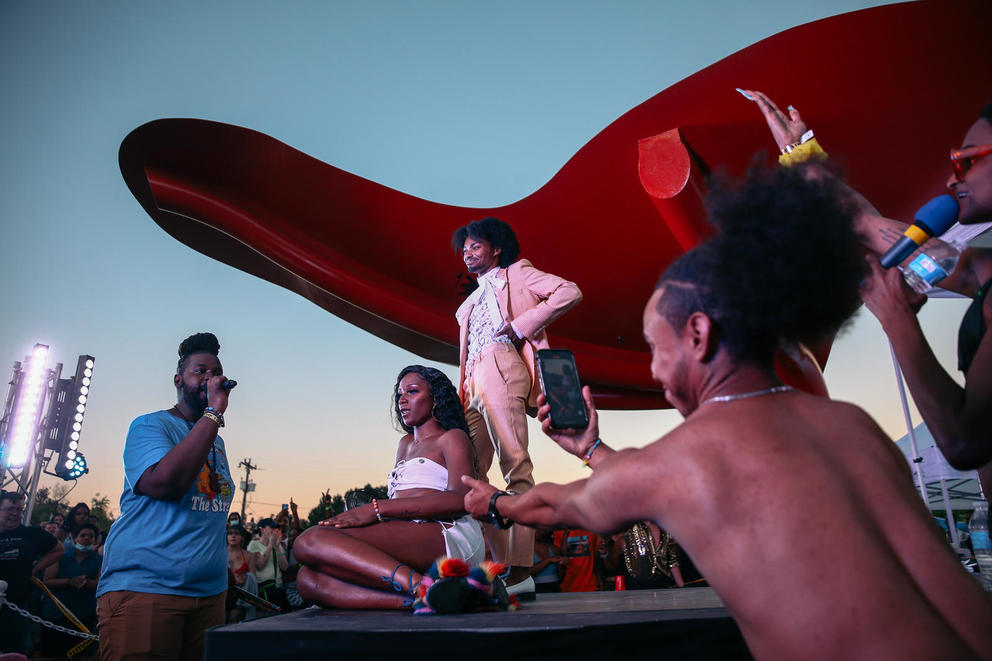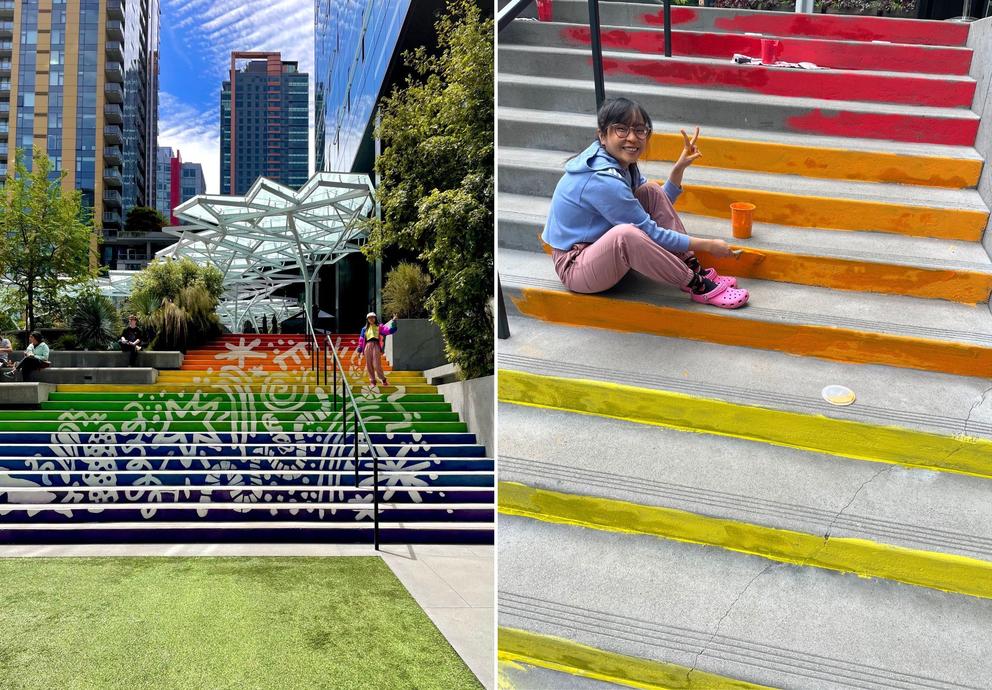I’ve been focused on the project for more than a year, working with an exceptional group of Black storytellers who made these profiles sing. Project editors Kemi Adeyemi and Jasmine Jamillah Mahmoud contributed in-depth written profiles (as well as being my constant Zoom companions). Filmmaker Tifa Tomb directed and produced five revealing video documentaries. Photographer Meron Menghistab conceived of and created powerful photo portraits. Crosscut’s emerging journalist fellow Brooklyn Jamerson-Flowers created a podcast about the local spaces that have fostered Black art and artists.
ArtSEA: Notes on Northwest Culture is Crosscut’s weekly arts & culture newsletter.
As project manager, I’ve been deep down in the details of these stories. But one of the things I think is so cool about Black Arts Legacies is the bird’s-eye view — where you start to see the connections between the artists that create an invisible map across time.
For example: Dancer Edna Daigre persuaded Kabby Mitchell to move to Seattle, where he became the first Black dancer at the Pacific Northwest Ballet. Daigre taught for a time at Black Arts/West, the 1960s performing arts company started by Douglas Q. Barnett. Painter Al Doggett made the promotional materials for Black Arts/West back then; decades later, he created set paintings for a play staged by director Valerie Curtis-Newton.
Doggett also collaborated with his partner, Esther Ervin, on the artwork for the Liberty Bank development. Ervin also contributed public art to the development at 23rd Avenue and Jackson Street (as did Marita Dingus and Elisheba Johnson) and was previously an artist in residence at sculptor James W. Washington Jr.’s historic Central District studio. Barry Johnson created the new bronze sculpture of Washington Jr. at Midtown Square. And I haven’t even mentioned the musical connections! (I’ll save those for another day ... but you’re getting a hint with the image of The Black Tones, above.)
Certain places, too, popped up again and again: Mount Zion Baptist Church as a source of artistic community, from hosting art shows by Washington Jr. to influencing the vocals of grunge rocker Tina Bell; the Langston Hughes Performing Arts Institute as an artistic incubator; and the Central District as a formative neighborhood — once bustling with Black businesses, then an object lesson in displacement, and now seeing the return of Black art in public spaces.
In early meetings I had with Vivian Phillips, a consulting producer on Black Arts Legacies, we talked a lot about these deep connections, and how they create a supportive web of Black community in a majority-white city. To me, the connections seem to light up across our new project, amassing into a sparkling artistic constellation. — B.D.
Roldy Aguero Ablao of the CHamoru Queer art collective Guma' Gela' facilitates a cardboard flower making workshop at flower flower, a new art space in the Chinatown-International District on May 22, 2022 in Seattle. The flowers will decorate Hing Hay Park on June 4 for The CHinalek Festival. (Jovelle Tamayo for Crosscut)
Speaking of things to celebrate, a long-planned event is taking place this weekend in the Chinatown-International District’s Hing Hay Park: the CHinalek festival (June 4, noon-6 p.m.), which translates to “flower” and “laughter” in CHamoru, the language of the eponymous Indigenous people of the Mariana Islands.
“We believe that flowers bring joy, laughter and healing,” write the organizers, a local group of queer and trans CHamoru and Asian artists. “This festival is a celebration of all the different ways flowers show up in our lives.”
And the blooms will be booming: There will be free flower giveaways, cardboard flowers and felt flower flags strung across the park, poetry performances, art installations and a flower-themed treasure map directing visitors to gingko trees and azaleas, as well as to places to find flower products, drinks and food in the neighborhood (of note: Hood Famous Bakeshop is creating a special flower-themed cocktail).
The festival is also the official opening celebration of flower flower, a new community art space on South Jackson Street (where you’ll find vendors selling houseplants, paintings, ceramics and more during the festival). Borne out of the Seattle Restored program, a public-private partnership that helps artists and creatives “activate” empty storefronts, the space is “not a flower shop,” the organizers say — the idea is that it can function as a greenhouse for creativity in the neighborhood.
During a visit a few weeks ago, co-founder Monyee Chau described the space (which at that point was still somewhat bare, waiting to be adorned with flowers, murals and art) as a community art studio meets creative co-working space and “baby of our collective’s dreams and hopes.” Chau co-founded the space with Lourdez Velasco, So’le Celestial and Roldy Ablao of the Guma' Gela' art collective (a group of queer CHamoru artists) and artist Jae Eun Kim.
“We really believe that art is a means to be able to create healing for our communities,” Velasco said. “Flower flower is so special because we’re hoping to create more resources and accessibility for artists. People are curious about art and don’t always have the resources — or just want to be in community to make art together. Specifically, we’re hoping that our queer and trans communities, or Black, Indigenous, people of color communities can find some of solace and sweetness here.” — M.V.S.
The advent of June brings yet another opportunity for celebration: Pride Month. While we’re seeing a post-lockdown panoply of in-person happenings and nonvirtual parades across the region — this website is a good place to explore — we wanted to highlight a few artsy ways to celebrate Pride.
Let’s start off with a dream ticket for this weekend: the So Dreamy music festival (June 4-5). Taking place at Café Racer and Vermillion on Capitol Hill, the showcase features queer BIPOC musicians, including local rock faves Black Ends and Tres Leches (who will spin a DJ set), as well as electro-hip-hop artist CarLarans and and indie-pop-project Supercoze.
Nearby, in Volunteer Park, Seattle Pride in the Park is hosting a free event co-curated with Taking B(l)ack Pride, MC’d by beloved burlesque performer Goddess Briq House and drag king Ceasar Hart, and headlined by Fly Moon Royalty.
While its status as an LGBTQ+ epicenter may be shifting, Capitol Hill has long been known as Seattle’s “gayborhood.” This wasn’t always the case. From late 19th century through much of the 20th century, Pioneer Square was the central gathering place for the local queer community. (Some of the first Seattle Pride events, including the Gay Pride Picnic, were held in Occidental Park in 1974.)
You’ll learn about this and much, much more on The Queer History Tour, a guided walking tour — premiering this month — that will bring you back to Pioneer Square’s queer roots (Wednesdays at 7 p.m.). If you prefer pedals over bipedalism, consider the Seattle Queer History Bike Ride, a 5.6 mile LGBTQ+ history cycling tour co-organized by The Museum of Pop Culture (MoPOP) and the Cascade Bicycle Club (Sunday, June 12, noon).
In South Lake Union, Molly Vaughan is asking for active participation in what the Seattle artist calls an act of “trans-allyship.” As part of her immersive and interactive art installation Safety in Numbers at MadArt Gallery, visitors can volunteer to receive a haircut identical to Vaughan’s (a bob), in order to call attention to “the power of anonymity and how it provides people the ability to move through society harassment free,” the exhibition copy notes. (The opening hair-cutting performance takes place tonight, Thursday, 6-8 p.m.; the show will be open throughout the month.)
Also in SLU: Seattle’s favorite creator of abstract exploding-rainbow paintings, Nikita Ares, just finished transforming the steps near the Amazon Spheres into a bright rainbow, hiëroglyphed with white iconography. Step back to enjoy the totality of the composition (created with local nonprofit Urban Artworks), which bursts with celebratory stars, festive serpentine swirls, confetti and pictorial exclamations of joy.
And for more queer joy outside of Seattle city limits, don’t miss Joey Veltkamp’s solo show of quilts, aka “soft paintings,” in Spirit! (at Bellevue Arts Museum through Oct. 23), a celebration of queerness, the Pacific Northwest and nostalgia. When we spoke ahead of the show’s premiere, Veltkamp told me that, as a queer artist, patchworking pain into something new was a necessity. And so, he says, he focuses on this task: “I’m gonna make beauty in this world.” — M.V.S.
Get the latest in local arts and culture
This weekly newsletter brings arts news and cultural events straight to your inbox.








